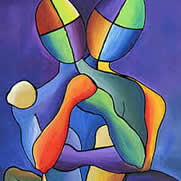Relationships Untangled
WHAT IS A RELATIONSHIP?
 The dictionary defines a relationship as “the way in which two or more people or things are connected, or the state of being connected” (Oxford Dictionaries online). However couples normally refer to a relationship as either a collection of activities (working, talking etc.) or as an ‘it’, a noun, static.
The dictionary defines a relationship as “the way in which two or more people or things are connected, or the state of being connected” (Oxford Dictionaries online). However couples normally refer to a relationship as either a collection of activities (working, talking etc.) or as an ‘it’, a noun, static.
I believe that what defines a relationship is how each of the involved parties relates to the other. It is a an active process, a living dynamic, which at the point of commencing therapy, can appear stagnant, possibly struggling to survive. In therapy, couples can safely and openly discuss counter productive cycles and become aware of their individual part in those dynamics in order to promote intimacy, closeness and change.
CULTURE VULTURE
Often we feel our partner comes from a very different place than we are. When we enter into a relationship we inherently bring our own “baggage” with it – what we expect form our partner, what we think our role is, how love “should” be, how to argue, fight & make up, etc. These are based on what we see around us in our immediate environment (family, friends) and in the wider cultural context (adverts, movies, books, social etiquette). When your partner comes from a different culture, the dynamics are likely to be even more complex.
We Often take these expectations for granted and as “truth” or as "rules" and they can cause conflict, misunderstanding and even loss of closeness and heartache. In therapy you can begin to explore what these expectations are in a safe and open environment and look to find a common ground and shared language. It doesn’t mean that all conflict will go away, but the manner that you approach it can dramatically alter and invite intimacy and openness.
THE PARADOX OF DYADS
Many writers discussed the delicate balancing act required between the needs of two people in a relationship. Berne (1961) wrote about autonomy and loving as the essential nature of Intimacy. Fromm (1963) differentiated between being loved and loving. The first is a dependent state where the latter is mature and more potent. Bugental (1965) suggested that our basic interpersonal task is “to be at one ‘a part of’ and ‘a-part-from’ “. Buber (1970) describe a wholly mutual and reciprocal relationship, where both sides experience each other fully, and coined it the “I-Thou relationship”. Yalom mused that love is “a positive act, not passive affect; it is giving, not receiving” (1980:371) and therefore requires greater awareness and acceptance. He compared growth limiting relationships to “‘A-frame’ dwellings, where the component walls support each other and when one shifts the other one falls.
The common denominator of these ideas seems to lie in the paradox of dyads; one that is inherently based on the tension between two people wanting to unite at the same time as wanting a certain distance; that whilst maintaining and active loving engagement with the other, it is imperative to individuate from the “We” and the other “You”. In therapy we can discuss how to go about and manage this paradox better.